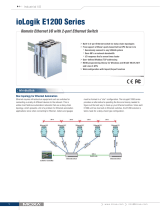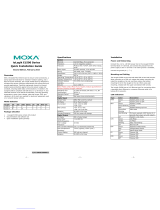Page is loading ...

P/N: 1802025000032
*1802025000032*
ioLogik 2500 Series
Quick Installation Guide
Smart Remote I/O
Edition 5.0, December 2016
Technical Support Contact Information
www.moxa.com/support
Moxa Americas:
Toll
-free: 1-888-669-2872
Tel:
1-714-528-6777
Fax:
1-714-528-6778
Moxa China (Shanghai office):
Toll
-free: 800-820-5036
Tel:
+86-21-5258-9955
Fax:
+86-21-5258-5505
Moxa Europe:
Tel:
+49-89-3 70 03 99-0
Fax:
+49-89-3 70 03 99-99
Moxa Asia-Pacific:
Tel:
+886-2-8919-1230
Fax:
+886-2-8919-1231
Moxa India:
Tel:
+91-80-4172-9088
Fax:
+91-80-4132-1045
2016 Moxa Inc. All rights reserved.

- 2 -
Package Checklist
• ioLogik 2500 series device
• 3-pin screw terminal block (for power input)
• 2 12-pin screw terminal blocks (for I/O)
• 2 8-pin RJ45-to-DB9 cables (CBL-RJ45M9-150)
• 1 antenna (only for wireless modules)
• Quick installation guide (printed)
Appearance
Top View
Front View

- 3 -
Physical Dimensions (unit = mm/inch)
Specifications
LAN
Ethernet
• 4 switched 10/100 Mbps RJ45 ports
• 1 optimized port for faster downstream
communications with daisy-chained ioLogik
E1200 units
Note: The optimized daisy-chain port is not supported on wind industry
devices (ioLogik E1261W-T, E1261H-T, or E1263H-T)
Protection
1.5 kV magnetic isolation
Protocols
Modbus/TCP, TCP/IP, UDP, DHCP, BOOTP,
SNMP, HTTP, CGI, SNTP, SMTP
WLAN (ioLogik 25xx-WL1)
Standards • IEEE 802.11a/b/g for wireless LAN
• IEEE 802.11i for wireless security
Spread Spectrum and
Modulation (typical)
• DSSS with DBPSK, DQPSK, CCK
• OFDM with BPSK, QPSK, 16QAM, 64QAM
• 802.11b:
CCK @ 11/5.5 Mbps, DQPSK @ 2 Mbps,
DBPSK @ 11 Mbps
• 802.11a/g:
64QAM @ 54/48 Mbps, 16QAM @ 36/24 Mbps,
QPSK @ 18/12 Mbps, BPSK @ 9/6 Mbps
Operating Channels
(central frequency)
• US:
2.412 to 2.462 GHz (11 channels)
5.18 to 5.24 GHz (4 channels)
• EU:
2.412 to 2.472 GHz (13 channels)
5.18 to 5.24 GHz (4 channels)
Security • 64-bit and 128-bit WEP encryption
• Full WPA/WPA2 Personal
Transmission Rates
• 802.11b: 1, 2, 5.5, 11 Mbps
• 802.11a/g: 6, 9, 12, 18, 24, 36, 48, 54 Mbps

- 4 -
TX Transmit Power
• 802.11b:
Typ. 18±1.5 dBm @ 1 to 11 Mbps
• 802.11g:
Typ. 18±1.5 dBm @ 6 to 24 Mbps,
Typ. 17±1.5 dBm @ 36 Mbps,
Typ. 16±1.5 dBm @ 48 Mbps,
Typ. 16±1.5 dBm @ 54 Mbps
• 802.11a:
Typ. 18±1.5 dBm @ 6 to 24 Mbps,
Typ. 16±1.5 dBm @ 36 Mbps,
Typ. 15±1.5 dBm @ 48 Mbps,
Typ. 14±1.5 dBm @ 54 Mbps
RX Sensitivity
• 802.11b:
-97 dBm @ 1 Mbps, -94 dBm @ 2 Mbps,
-92 dBm @ 5.5 Mbps, -90 dBm @ 11 Mbps
• 802.11g:
-88 dBm @ 6 to 24 Mbps, -
85 dBm @ 36 Mbps,
-75 dBm @ 48 Mbps, -70 dBm @ 54 Mbps
• 802.11a:
-88 dBm @ 6 to 24 Mbps, -
85 dBm @ 36 Mbps,
-75 dBm @ 48 Mbps, -70 dBm @ 54 Mbps
Cellular (ioLogik 25xx-GPRS/HSPA)
Band Options
• Five-Band:
UMTS/HSPA+(WCDMA/FDD) 800/850/
AWS1700/1900/2100 MHz
• Quad-band:
GSM/GPRS/EDGE 850/900/1800/1900 MHz
SIM Control Voltage
3.0 V/1.8 V
Power Requirements
Power Input
24 VDC nominal, 9 to 48 VDC
Physical Characteristics
Wiring
I/O cable max. 14 AWG
Dimensions
61 x 157 x 115 mm (2.4 x 6.18 x 4.53 in)
Weight
under 1.2 kg
Environment Limits
Operating Temperature
Standard Models:
Wide Temp. Models:
-10 to 60°C (14 to 140°F)
Ethernet: -40 to 75°C (-40 to 167°F)
Wireless: -30 to 70°C (-22 to 158°F)
Storage Temperature
-40 to 85°C (-40 to 185°F)
Ambient Relative
Humidity
5 to 95% (non-condensing)
Altitude
Up to 2000 m
Note: Please contact Moxa if you require products guaranteed to function
properly at higher altitudes.
Digital Input
Sensor Type
Wet Contact (NPN or PNP) and Dry Contact
I/O Mode
DI or Event Counter
Dry Contact
• On: short to GND
• Off: open
Wet Contact
(DI to COM)
• On: 10 to 30 VDC
• Off: 0 to 3 VDC
Isolation
3k VDC or 2k Vrms
Counter/Frequency
2.5 kHz

- 5 -
Digital Output (Sink)
I/O Mode
DO or Pulse Output
Pulse Output Frequency
5 kHz
Over-voltage Protection
45 VDC
Over-temperature
Shutdown
175°C (min.)
Over-current Protection
1.5 A per channel @ 25°C
Current Rating
500 mA per channel @ 25°C
Isolation
3k VDC or 2k Vrms
Analog Input (ioLogik 2542)
Type
Differential input
Resolution
16 bits
I/O Mode
Voltage / Current (software selectable)
Input Range
±10 V, 0 to 10 V, 0 to 20 mA, 4 to 20 mA (with
burn-out detection)
Accuracy ±0.1% FSR @ 25°C
±0.3% FSR @ -10 and 60°C
±0.5% FSR @ -40 and 75°C
Sampling Rate
• All channels: 400 samples/sec
• Per channel: 100 samples/sec
Input Impedance
> 1M ohms (min.)
Built-in Resistor for
Current Input
120 ohms
Warranty
Warranty Period
5 years
Details
See www.moxa.com/warranty
Hardware Installation
I/O Wiring
Digital Inputs/Outputs
Analog Inputs
Mounting
There are two sliders on the back of the unit for DIN rail and wall
mounting.
• Mounting on a DIN rail
Pull out the bottom slider; latch the unit onto the DIN rail, and the
push the slider back in.
• Mounting on a wall (optional)
Pull out both the top and bottom sliders and align the screws
accordingly.

- 6 -
Connecting the Power
Connect a 9 to 48 VDC power line to the ioLogik 2500’s terminal block V+
terminal
; connect the ground from the power supply to the V- terminal.
For most applications, it is
desirable to ground the system
by connecting the system’s
power supply common wire to
the chassis or panel ground. The
negative (
–V) side of the DC
power
input terminal as well as
all I/O point terminals labeled
GND should be connected to
chassis ground.
NOTE
For safety reasons, wires connecting the power supply should be
at least 2 mm in diameter (e.g., 12 gauge wires).
Connecting to a Network
The ioLogik 2500 has four built-in RJ45 Ethernet ports for connecting
standard direct or crossover Ethernet cables.
LED Indicators
Type
Color
Description
Power
(PWR)
Green
System power is ON
Off
System power is OFF
Ready
(RDY)
Green
System ready
Red
System error
Off
System is not ready
Ethernet Port
(L1/L2/L3/L4)
Green
Ethernet connection enabled in 100 Mbps
Amber
Ethernet connection enabled in 10 Mbps
Flashing
Data transmitting
Off
Disconnected

- 7 -
Type
Color
Description
Serial Port
(P1/P2)
Green
Tx
Amber
Rx
Flashing
Data transmitting
Off
Disconnected
SD
Green SD card inserted
Flashing
SD card being accessed
I/O Channel
Status*
Green
Channel ON
Off
Channel OFF or No Counter/Pulse Signal
W.Link**
Green
Cellular connection established
Off
Off
Signal Status**
Off
No signal, or No SIM card
1 LED
Weak or insufficient (SMS only)
2 LEDs
Average (good for cellular connections)
3 LEDs
Excellent signal
*Use the rotary switch to select which module's I/O channel status is
displayed.
**Wireless Modules Only.
System Configuration
Configuration via IOxpress Utility
The configuration of the ioLogik 2500 is mainly done with the IOxpress
utility. IOxpress is a search utility that helps users locate an ioLogik 2500
device on the local network. The latest version of the utility can be
downloaded from Moxa's website.
• Default IP Address: 192.168.127.253
• Default Subnet Mask: 255.255.255.0
NOTE
Be sure to configure the host PC’s IP address to the same subnet
as the ioLogik 2500. For example, 192.168.127.253
Load Factory Default Settings
There are three ways to restore the ioLogik 2500 to factory default
settings.
1. Hold the RESET button for 5 seconds.
2. In the IOxpress utility, right-click on the ioLogik device to be reset
and select Reset to Default.
3. Select Load Factory Default from the web console.
WARNING
This equipment is intended to be used in Restricted Access
Locations. External metal parts are hot! Before touching
it,
special attention or protection is necessary.
How to Download the Software
Step 1: Click on the following link to open the Support & Downloads
search tool:
http://www.moxa.com/support/support_home.aspx?isSearchShow=1

- 8 -
Step 2: Type the model name in the search box or select a product from
the drop down box and then click Search.
Step 3: Click the Software Packages link to download the latest
software for the product.
ATEX Information
1. Certificate number: DEMKO 15 ATEX 1603X
2. Certification string: Ex nA IIC T4 Gc
3. Standards covered:
EN 60079-0:2012+A11:2013, EN 60079-15:2010
4. The equipment shall be installed in an enclosure that provides a
degree of protection not less than IP54 in accordance with EN
60079-15 and accessible only by the use of a tool.
5. These products are for use in an area of not more than pollution
degree 2 in accordance with EN 60664-1.
/


